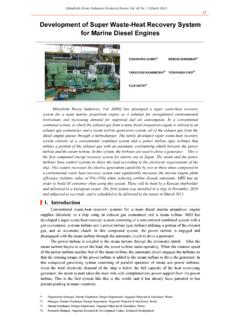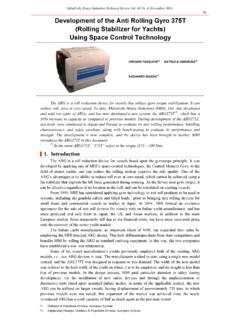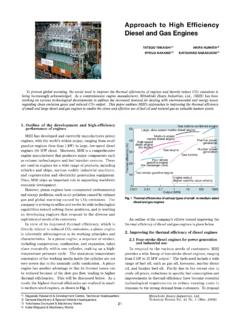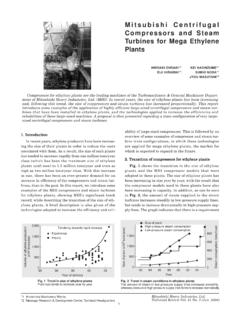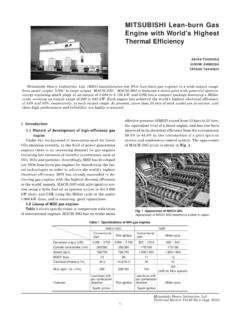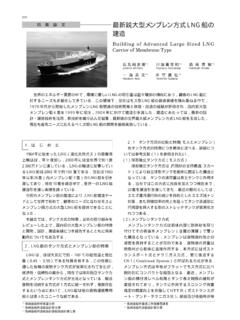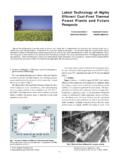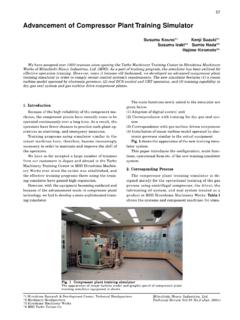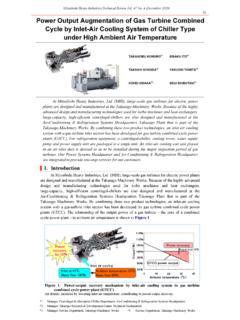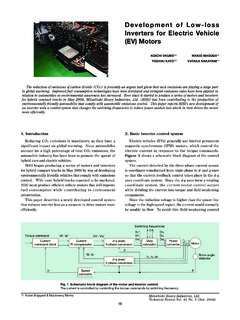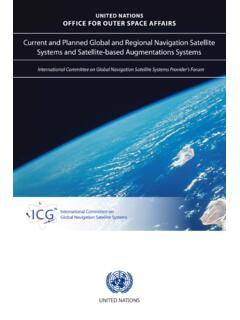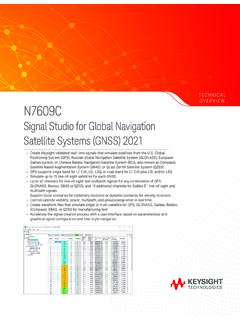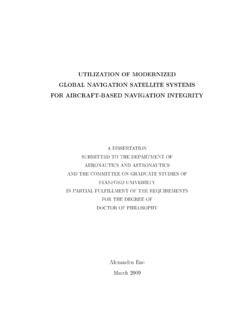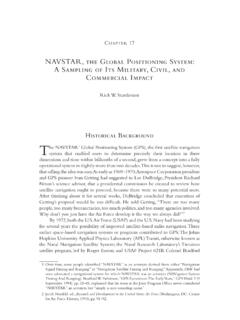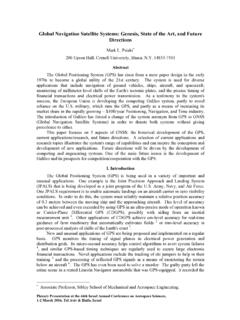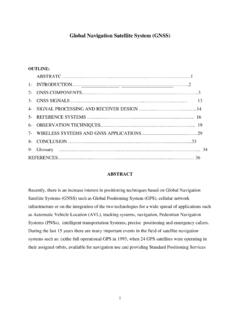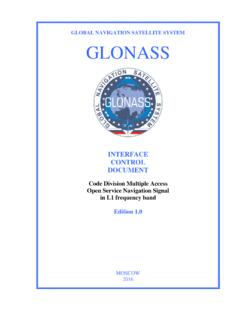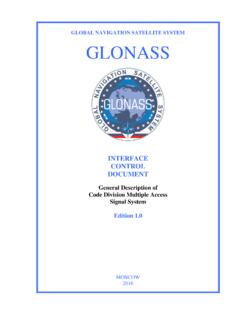Transcription of System Evaluation Test of Global Navigation Satellite ...
1 Mitsubishi Heavy Industries Technical Review Vol. 50 No. 4 (December 2013) 15 *1 Manager, Electronic Control Technology Department, Land Transportation Systems Division, Commercial Aviation & Transportation Systems *2 Electronic Control Technology Department, Land Transportation Systems Division, Commercial Aviation & Transportation Systems *3 Chief Staff Manager, Takasago Research & Development Center, Technology & Innovation Headquarters *4 Manager, MHI Engine System Asia Pte Ltd. System Evaluation Test of Global Navigation Satellite System -based Road Pricing System RYOTA HIURA*1 TAIZO YAMAGUCHI*2 YOSHIHIRO MABUCHI*2 TAKUMA OKAZAKI*2 MASATO IEHARA*3 TAKESHI FUKASE*4 An autonomous road pricing System charges according to the charging points that the carhas passed and the travel distance, based on location information provided by the GlobalNavigation Satellite System (GNSS).
2 It is expected that this System will solve problems related to automobile traffic through the reduction of economic loss due to traffic congestion, the lowering ofenvironmental burden, the recovery of road maintenance costs, etc. In order to bring anautonomous road pricing System into practical use, it is necessary to obtain the trust of stakeholders including drivers. This is achieved by demonstrating that the System can levy chargesconsistently and stably regardless of the travelling patterns or positioning errors that may bemagnified depending on the environment. Mitsubishi Heavy Industries, Ltd. (MHI) has been enhancing the reliability of charging functionality through the improvement of positioningaccuracy with use of the dead reckoning and map matching methods.
3 Furthermore, MHI hasrecently improved the reliability of the System from the driver's perspective by eliminatinginconsistencies in the position/timing of indicating and informing the driver of the charge. The developed System has been field tested widely on public roads (expressways, general roads, in urban and rural areas, etc.) in Singapore where MHI aims to put this System into practical use, andhas confirmed that its reliability and accuracy are sufficient therefore. |1. Introduction As a road pricing System designed for the reduction of traffic congestion and toll collection, the DSRC (Dedicated Short Range Communication) System is widely used. However, the DSRC System requires equipment including radio communication antennas for each point where thecharging is performed, and is not suitable for accurate charging at multiple points and frequent roadchanges subject to tolls depending on the traffic congestion conditions.
4 On the other hand, an autonomous road pricing System using Global Navigation SatelliteSystem technology has the advantages of being able to charge accurately according to the traveldistance and easily change the toll setting. Therefore this System is attracting attention as a methodnot only for the alleviation of traffic congestion, but also for the collection of road maintenance costs to replace the fuel tax. In fact, autonomous road pricing systems have been increasingly introduced in Europeancountries including Germany[1] and Slovakia[2]. These introductions aim to collect road maintenance costs. The rough traveling routes and distances travelled by heavy vehicles can beidentified and accumulated, and tolls collected later.
5 In Singapore, there is a move to replace Electronic Road Pricing (ERP), which is a tollingmethod using the DSRC System that has been used for the alleviation of traffic congestion, with an Mitsubishi Heavy Industries Technical Review Vol. 50 No. 4 (December 2013) 16 autonomous road pricing System . The reasons include the reduction of roadside equipment and theelimination of unfairness felt toward charging points. For this congestion charging, it isnecessary to charge on certain roads and areas where the alleviation of traffic congestion is desiredwhile informing drivers accordingly. Satisfying stricter conditions related to accuracy on roadssubject to toll, the correctness of charging, real time information capacity (accuracy of indicating position), etc., is required in comparison to prior European examples.
6 It is also necessary to assurethe correctness and reliability of the enforcement System in order to maintain the operation. MHI, the supplier of the ERP System currently used in Singapore, has been developing anautonomous road pricing System that meets globally unprecedented demanding requirements.[3][4]Aiming at practical application, MHI performed a large-scale Evaluation test to verify the functions and reliability of the entire System in Singapore in 2012. In this Evaluation test, the System wasexhaustively tested based on the performance indicators for each of charging accuracy (checking ifthe correct toll is levied), charge display timing (checking if the driver can be informed of the charged amount without geographical variation around charging points), and detecting illegality(checking if illegalities such as vehicles having no onboard unit can be found).
7 |2. Overview of Autonomous Road Pricing System The autonomous road pricing System levies charges according to the charging points that thecar has passed and the travel distance, based on location information provided by the On-Board Unit (OBU) mounted on a vehicle. This System consists of four subsystems: the Central Computer System (CCS) that collects information as shown in Figure 1, the Enforcement System (ES) that detects illegality, and the Roadside Unit (RSU) antenna that transmits and receives traffic andlocation information to and from vehicles, in addition to the OBU. An overview of the subsystemsis described below. Figure 1 System diagram OBU (On-Board Unit) The OBU is mounted within a vehicle and performs charge levy processing independentlybased on the positioning results.
8 It also transmits information about the charging result and thevehicle location to the CCS. In order to attain stable charging regardless of variations in the GNSS signal, the OBU has acceleration sensors and gyroscopes, and information from the sensors is used for estimating position with GNSS information to improve positioning accuracy. The use of thistechnology is referred to as the dead reckoning method. Using map matching (technology forassociating location information with a digital road map) of the obtained location information, the Mitsubishi Heavy Industries Technical Review Vol. 50 No. 4 (December 2013) 17 travel route and the charging points that the car has passed are determined on the map, and thencharging is performed. In addition, the processing time needed is compensated for by predicting thevehicle location after several seconds, and therefore the user can be informed when passing acharging point without delay.
9 CCS (Central Computer System ) The CCS is a central System that transmits and receives information to and from eachsubsystem. To and from the OBU the CCS receives charges levied and transmits a schedule ofcharges. From the ES the CCS receives monitoring information to summarize violations. From theRSU the CCS collects vehicle information based on the results of communication with the OBU and transmits traffic information to the OBU to guide vehicles to less congested roads to supportcomfortable driving. ES (Enforcement System ) The ES has two types as shown in Figure 1: The Roadside Enforcement System (RES),which is a fixed monitoring System on the road, and the Mobile Enforcement System (MES), whichis a simple monitoring System using monitoring equipment mounted on a vehicle or the roadshoulder.
10 Both types have a license plate number recognition function and a communicatingfunction with the OBU through the DSRC, and check the obtained information to detect violationssuch as the failure of charging due to the lack of a stored value card being inserted into OBU. RSU (Roadside Unit) The Roadside Unit (RSU) is communication equipment installed on the roadside that transmits traffic information and positioning augmentation signals to vehicles/OBU passing positioning augmentation signal provides location and road information to the OBU when thevehicle is in a high-rise area where GNSS positioning accuracy worsens or at a branch where thedetermination of actual location is difficult with only location information. The RSU is also used tocollect traffic information from the OBU.
